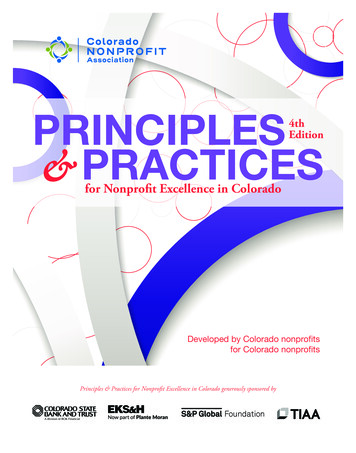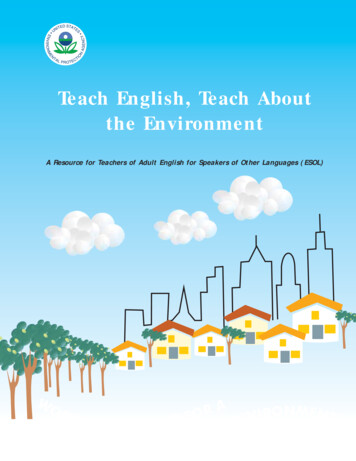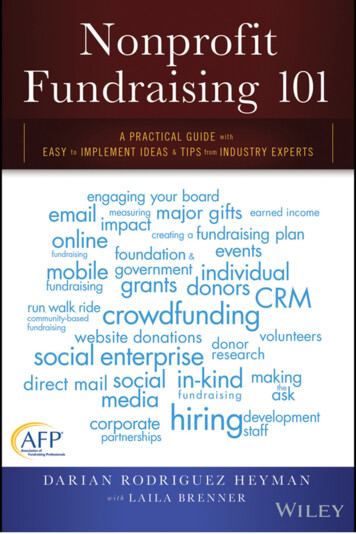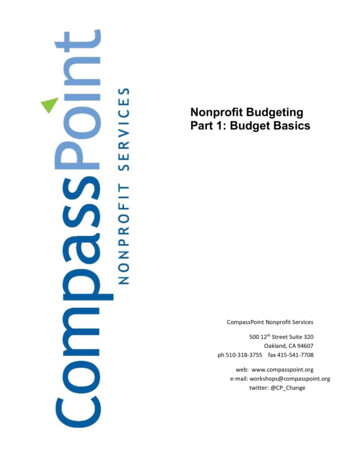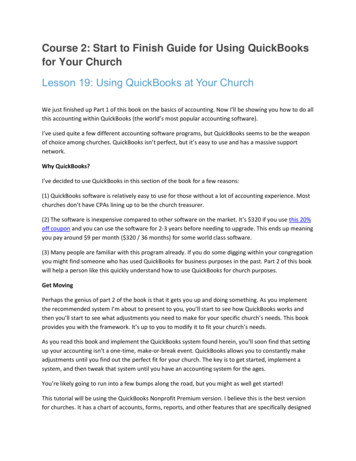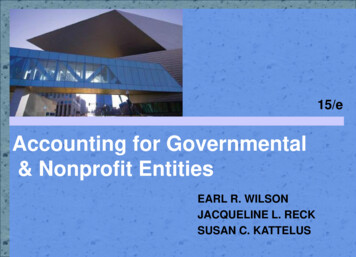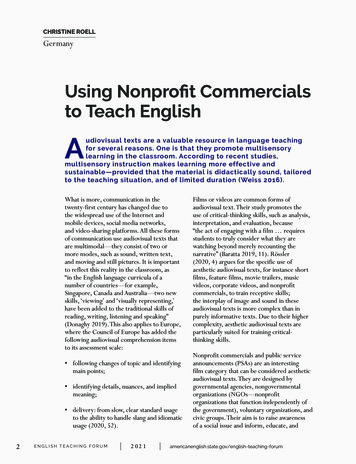
Transcription
CHRISTINE ROELLGermanyUsing Nonprofit Commercialsto Teach EnglishAudiovisual texts are a valuable resource in language teachingfor several reasons. One is that they promote multisensorylearning in the classroom. According to recent studies,multisensory instruction makes learning more effective andsustainable—provided that the material is didactically sound, tailoredto the teaching situation, and of limited duration (Weiss 2016).What is more, communication in thetwenty-first century has changed due tothe widespread use of the Internet andmobile devices, social media networks,and video-sharing platforms. All these formsof communication use audiovisual texts thatare multimodal—they consist of two ormore modes, such as sound, written text,and moving and still pictures. It is importantto reflect this reality in the classroom, as“in the English language curricula of anumber of countries—for example,Singapore, Canada and Australia—two newskills, ‘viewing’ and ‘visually representing,’have been added to the traditional skills ofreading, writing, listening and speaking”(Donaghy 2019). This also applies to Europe,where the Council of Europe has added thefollowing audiovisual comprehension itemsto its assessment scale: following changes of topic and identifyingmain points; identifying details, nuances, and impliedmeaning; delivery: from slow, clear standard usageto the ability to handle slang and idiomaticusage (2020, 52).2ENGLISH TEACHING FORUM2 02 1Films or videos are common forms ofaudiovisual text. Their study promotes theuse of critical-thinking skills, such as analysis,interpretation, and evaluation, because“the act of engaging with a film requiresstudents to truly consider what they arewatching beyond merely recounting thenarrative” (Baratta 2019, 11). Rössler(2020, 4) argues for the specific use ofaesthetic audiovisual texts, for instance shortfilms, feature films, movie trailers, musicvideos, corporate videos, and nonprofitcommercials, to train receptive skills;the interplay of image and sound in theseaudiovisual texts is more complex than inpurely informative texts. Due to their highercomplexity, aesthetic audiovisual texts areparticularly suited for training criticalthinking skills.Nonprofit commercials and public serviceannouncements (PSAs) are an interestingfilm category that can be considered aestheticaudiovisual texts. They are designed bygovernmental agencies, nongovernmentalorganizations (NGOs—nonprofitorganizations that function independently ofthe government), voluntary organizations, andcivic groups. Their aim is to raise awarenessof a social issue and inform, educate, m
These films are an inspiring resource in the English classroombecause various narrative devices and cinematic techniquesare used to achieve the organizations’ goals andbecause they provide ample opportunities for languagepractice and development of critical thinking.persuade viewers to take action, encourage achange in behavior, offer assistance, or appealfor donations. They address issues that includepoverty, the plight of refugees, bullying,domestic violence, health, and safe driving. Awell-made nonprofit commercial entertains,educates, and stimulates its audience.complete story. They can be integrated intoa lesson of topic-based language learning(where the contents of the lesson arearranged around a topic); they can also be asubject for language practice or a resourcein project-based learning. Different types of learners can benefitThese films are an inspiring resource in thefrom the films because they communicateEnglish classroom because various narrativethrough multiple channels—images,devices and cinematic techniques are used tosound, speech, and text.achieve the organizations’ goals and becausethey provide ample opportunities for language Films with minimal speech (or no speech atpractice and development of critical thinking.all) can be selected for low-level students,This article discusses techniques that nonprofitand activities can be adapted accordingly.commercials employ, shows ways of exploitingthem for teaching English, and provides a The films can be used in communicativelist of films in the Appendix that may be oflanguage activities to develop an arrayinterest to English language teachers.of skills, including listening and readingcomprehension, writing (analysis andreviews), speaking (discussion andADVANTAGES OF USING NONPROFITpresentation), information analysis, andCOMMERCIALS IN THE ENGLISHresearch.CLASSROOMNonprofit commercials (in this article alsoreferred to as “films”) are a valuable resourcefor language teachers for the followingreasons: The aim of the commercials is to reachas many people as possible to spread anorganization’s message and promote itscause. Therefore, they are freely availableon the Internet and can be watched andshared from any place with an Internetconnection or with a mobile device. The films are short—usually less thanthree minutes long—but most areprofessionally made and frequently tell a The films can serve as a springboard todiscuss important global issues that are ofteninterlinked, for instance social, ecological,and socio-economic concerns (Grimm,Meyer, and Volkmann 2015, 163–164). Film and critical-media literacy aredeveloped when students analyze the filmsand study the websites of the organizationsthat released them.To make full, productive use of these films,teachers should (1) become familiar with thetypes of films available and the causes theyrelate to; (2) understand how the films canbe used in language teaching; (3) have at rum2021ENGLISH TEACHING FORUM3
a basic knowledge of narrative elements andcinematic techniques to allow both teachersand students to describe the films they chooseto study; and (4) preview the films beforeshowing them to students to make sure thecontent of the films is appropriate for theircontext.NARRATIVE ELEMENTS OF FILMSImportant elements of the narrative of a filmare the plot, the setting, the characters, andthe point of view. Narrative techniques usedin the nonprofit commercials presented hereinclude telling a story from a subjective pointof view, role reversals, and plot twists.A story can be presented as if the narratoris an objective third party who watches theaction from the sidelines, or it can be toldfrom a character’s subjective reality. This doesnot necessarily refer to the character’s opticalviewpoint. It means that the audience perceivesthe world subjectively as it is reflected in thecharacter’s consciousness—which may hear andsee things that seem real to the character butare not real in the film’s world.For example, a film titled Fragile Childhood:Monsters depicts children engaging in everydayactivities, like playing on a playground andeating ice cream. The children, who lookdistraught, are accompanied by figures thatseem to have sprung from a horror movie. Theviewers are not sure what is going on untilthe question, “How do our children see uswhen we’ve been drinking?” is shown towardsthe end. It becomes clear that the audience ispartaking in the children’s subjective realityby witnessing how they perceive their drunkTechniqueShot sizesExamples Aerial shot. Captures the view of the action going on below Extreme long shot. Often used as an establishing shot to set up thelocation for the scene; the frame is dominated by a landscape or asetting. Long shot. Shows the character in the film in his or her entirety Medium shot. Shows the subject “from around the knees or waist tothe top of the head” (Archambault 2015) Close-up and extreme close-up. The subject fills the entire frame.These shots are effective in conveying a character’s emotions and indrawing attention to significant objects and details in a scene (Kuhnand Westwell 2012, 84).Camera angles Cameramovements Tilt. The camera moves up and down. Pan. The camera moves horizontally. Track. The camera is moved away from or towards a scene to followthe action. Hand-held camera. The jerky movement conveys a sensation ofauthenticity and immediacy. Point-of-view shot. A subjective shot from a character’s viewpointSpecial effects Physically or digitally created camera effects, such as reversemotion, fast motion, and slow motionHigh angle. The camera is placed above the subject.Eye line. The camera is placed at eye level.Low angle. The camera is placed below eye level.Dutch angle. The camera angle is deliberately slanted to one side,usually to create unease inside the mind of the viewer.Table 1. Overview of common cinematic techniques4ENGLISH TEACHING FORUM2 02 1americanenglish.state.gov/english-teaching-forum
parents as monstrous figures. (Note: Links tofilms referenced in this article, among others,are listed in the Appendix.)Amnesty International’s When You Don’tExist portrays the traumatic experiences ofrefugees. The film uses a plot twist when itturns out that the roles have been reversed:the refugees are not from an African, LatinAmerican, or Asian country but, contraryto expectations, white Europeans who seekrefuge in Africa.CINEMATIC TECHNIQUESA number of techniques are inherent infilmmaking, including lighting, camera angles,camera movement, cuts and transitions, andsound. Filmmakers use them to, for example,create a dramatic effect, build suspense,influence the viewers’ emotional reaction, andmake us sympathize with a character.Table 1 provides an overview of commoncinematic techniques; more techniquesand further explanations can be found atArchambault (2015) or by searching onlinefor “cinematic techniques.”For example, camera angles and cameramovement can produce attention-grabbingvisual effects, and “the relationship betweenthe camera and the object being photographed(i.e., the ANGLE) gives emotional informationto an audience, and guides their judgmentabout the character or an object in the shot. Themore extreme the angle the more symbolicand heavily-loaded the shot” (Wilson 2013).The film A Tale of Two Mothers—part of avaccination campaign—employs both thesplit-screen technique and parallel editing tocreate the impression of simultaneity whenshowing the routines of two mothers lookingafter their babies. In Refugees:The Shared Storyof Harry and Ahmed, the split-screen techniquejuxtaposes two persons on the screen andshows clips of their refugee experiencesside by side to highlight their similarity. Thecommercial WaterWalk occasionally employsslow motion to draw the viewer’s attention toan African girl’s long and arduous trip to fetchwater. And in Domestic Abuse Advertisement,slow motion and other special effects show avictim’s possessions being dragged into a pile,as if moved by an invisible hand.Another key element of film language is sound,which includes speech (dialogue or voiceover),music, sound effects, and silence. Soundinfluences the viewer’s emotional reaction, forexample by building or releasing tension and byenhancing a dramatic or comic moment.Soundtrack dissonance is the use of asoundtrack that contrasts with the visualsubject or activity. The film Talk toYour KidsAbout Alcohol uses dissonant sound to conveyits message: A father makes claims about thesupposed benefits of social drinking; however,he speaks not with a male voice but withdifferent children’s voices. Then a messageis shown: “Make sure you’re the one whotalks to your kids about the risks of alcohol.”The incongruity between the kids’ voicesand the image of an adult man highlights theimportance of parents talking to their kidsabout alcohol before other influential personsin their lives persuade them to consume it.Animation is an art form that is sometimesused to explain complex relationships in asimplified way and communicate informationwith visuals. The short film The Journeyof Plastic shows how a plastic bottle that isthrown away ends up in the food chain.Educate a Girl and She Will Change the World alsouses visual instead of verbal input.In the animated film There’s a Monster in MyKitchen, close-ups and extreme close-ups areused to show the feelings of the protagonist.High-angle camera shots create a sense ofmenace.WAYS TO EXPLOIT NONPROFITCOMMERCIALS IN THE LANGUAGECLASSROOMFollowing are ways for teachers to usenonprofit commercials through topic- andproject-based learning. The sequence g-forum2021ENGLISH TEACHING FORUM5
Teachers can show a nonprofit commercial to introduce a topic;they can also show two or more films that cover the same issueto compare their stylistic features and methods of persuasion.here moves from (1) watching and analyzing afilm as a class; (2) discussing the film and thetopic; (3) independently watching and analyzinga different film individually or in groups, thensharing information and ideas; and (4) as anoption, in groups, choosing a cause and makinga storyboard and film to promote it.TOPIC-BASED LEARNINGTeachers can show a nonprofit commercialto introduce a topic; they can also showtwo or more films that cover the sameissue to compare their stylistic features andmethods of persuasion. When teachers usethese commercials, it is helpful to follow themethod of incorporating pre-viewing, whileviewing, and post-viewing activities.While-viewing activities Have students watch and listen foranswers to questions—for example,about the setting and characters—and forkey words. Ask students to observe and notice specificdetails. Stop the film before the end, especially incase of a plot twist or surprise ending, andspeculate about what will happen.Post-viewing activities Talk about the film: “How does thecommercial make you feel? What doyou think the main message is? Do youthink the commercial is effective?Why/Why not?”Pre-viewing activitiesThe following pre-viewing activities createexpectations and prepare students to thinkabout and discuss the topic: Pre-teach or review relevant vocabulary. Activate students’ prior knowledgeabout the topic by asking what theyknow about it, showing pictures related toit, or having them talk about it witha partner. Listen to the soundtrack of the film orpart of the film and speculate on what it isabout. Watch the film or part of it without thesoundtrack and speculate on what it isabout. Show learners one or several screenshotsfrom the film to make them curious andspeculate about its content.6ENGLISH TEACHING FORUM2 02 1 Discuss the main message of the film. Discuss opinions and attitudes regardingthe topic. Describe the plot of the film andcompare the students’ descriptions(especially for films that are ambiguous insome way). Assign students to write a review orcomment on the film. Have the class conduct research on thetopic. Study global issues that are ofteninterlinked, such as environmentalproblems, water shortage, wars, andrefugee crises.It is recommended to watch a nonprofitcommercial at least twice—the first um
to ask for feedback regarding content andthe response to it, and the second time topay attention to cinematic techniques andanalyze them, thus promoting students’critical film literacy. The second viewinghelps “learners analyze and interpretmoving images, encouraging them to thinkcritically about film itself and lookingbeyond the surface of the screen, toconsider a film’s intentions and techniques”(Donaghy 2015, 32). This competence isimportant because “any attempt to ask largercultural or ideological questions about afilm is inadequate if it does not includesome reckoning with the work’s formaldimensions” (Dix 2016, 12–13).Additional viewingsStudents might also benefit from additionalviewings. Here is one possible approach:TWO TEACHING EXAMPLES BASED ONNONCOMMERCIAL FILMSRain ForestsThe issue of the destruction of rain forestsbecause of climate change is the focus ofGreenpeace’s film Every Step Counts to Save theAmazon. Language-focused activities includewriting a description, collaborating with otherstudents, expressing one’s opinion, and talkingabout routines.Pre-viewing activityThe matching exercise in Table 2 describesGreenpeace’s mission (Greenpeace 2021).Write the exercise on the board and askstudents to match the four verbs with theincomplete sentences to create a positivemessage.Go over the answers with students: 1. B; 2. D;3. A; 4. C.First viewing. Watch and try to understandthe language used and the overall message;Next, ask students what kind of organizationbecome aware of possible emotionalthey believe has established this mission.responses.After they make their guesses (and maybehave guessed Greenpeace), ask them whatSecond viewing. Watch and listen forthey know about Greenpeace and whatspecific words/terms, images, etc.expectations they have about a film that theorganization has made.Third viewing. Watch and focus more onthe narrative; after this viewing, workwith a partner to summarize the film and While-viewing activityask questions, then discuss.Tell students that they will view a short videoproduced by Greenpeace. After the first scene,Fourth viewing. Look for cinematicpause the film and have students speculate ontechniques and details that might havewhat the film is about. Then have them watchbeen missed earlier; discuss in pairs or asthe film until the end, where the objectivea class.of the campaign becomes obvious. Next,students work in pairs to write a descriptionof the events shown in the film. AfterFifth viewing. Watch one more time forfinishing, the pairs compare their text withoverall impact.1. Prevent2. Promote3. Protect4. EndA. biodiversity in all its forms.B. pollution and abuse of the earth’s ocean, land, air and fresh water.C. all nuclear threats.D. peace, global disarmament and non-violence.Table 2. Pre-viewing matching -forum2021ENGLISH TEACHING FORUM7
that of another pair. Depending on the size ofthe class, all or some of the descriptions canbe read aloud and compared.Students watch the film again (perhapsseveral more times) and answer the followingquestions: Is the intent of the film to inform or topersuade? Who is the target audience? What techniques are used to create animpact on the audience? What kind of sound is used? What is itseffect? What information is provided in theinserted texts? What is meant by the appeal to get sneakermanufacturers to “refuse to buy the leatherthat’s killing our future”? How does the film make you feel?Allocate one or two questions for each studentto focus on (although everyone should answerthe question “How does the film make youfeel?”). After rewatching the film, studentscongregate in groups to share their notes,which are later discussed by the whole class.In this film, reverse motion is used to tracesneakers back to destruction of the Amazonrain forest. In addition, the film employs acombination of images, text, energetic music,sound effects, and special effects like flashbackand flashing images to make an emotionalappeal.You can also draw the students’attention to the last scene, which shows the stillunspoiled rain forest in an aerial shot. The film,which addresses consumers in general, does notprovide any hard facts and figures; students candiscuss why the filmmakers decided to use thisapproach and how effective they think it is.Post-viewing activitiesTell students that agriculture is one majorreason for the deforestation of tropical rain8ENGLISH TEACHING FORUM2 02 1forests. According to Rainforest Concern(2021), “the forests are cut down to make wayfor vast plantations where products such asbananas, palm oil, pineapple, sugar cane, teaand coffee are grown. As with cattle ranching,the soil will not sustain crops for long, andafter a few years the farmers have to cut downmore rainforest for new plantations.”Ask students to brainstorm ways they canshop sustainably for food, clothes, and otherproducts; students discuss their ideas ingroups and then share with the class, whilea student writes the suggested ideas on theboard. Alternatively, students use self-adhesivenotes for their ideas, which can later beclustered on the board according to differentaspects. Students copy the results or take aphoto. They then discuss with a partner theideas they have already implemented into theirlives and how consistently they practice them(always, often, sometimes, or never)and the ideas they will or may implement inthe future.Another option is for students to take theinteractive self-test about their ecologicalfootprint at Global Footprint Network(2021). Or you can prepare your own surveyabout students’ everyday habits, especially ifyou want to provide lower-level students withrelevant vocabulary. Further materials, such astexts to read at home, are found at RainforestFoundation US (2021).Road SafetyA second example concerns road safety.One approach is for students to analyze andcompare two campaign films. Languageactivities include listening comprehension,talking about personal mobility, discussingthe effectiveness of road-safety campaigns,interacting in an informal discussion, andexpressing opinions.Pre-viewing activityAsk students about the means of transportthey use in their everyday lives and whatcriteria are important for them when decidingon a mode of mobility. Students ponder theadvantages and disadvantages of g-forum
Students can also watch and analyze a nonprofit commercialwith the specific aim of developing productive language skills.forms of mobility. Elicit the most importantcauses of road accidents and ask students ifthey remember any campaigns to promoteroad safety.While-viewing activityInform students that they will listen to aroad-safety campaign video before they watchit. Ask them to think about what the songthey will hear is about, to imagine what ishappening in the film, and to note down keywords. Then play the sound of Dramatic Textingand Driving PSA. After the class discusses whatthey heard, ask the following questions forfurther viewings of the film: What situation is shown in the film? Is the intent of the film to inform or topersuade? What techniques are used to create animpact on the audience? Who is the target audience? How does the film make you feel? Do you think it is effective?The class now watches the video—multipletimes if necessary—and discusses thesequestions. Then tell students that they willwatch another film related to road safety:Speeding. How Sorry Will You Be? First, askstudents to determine what the relationshipof the driver and the passenger is and to notedown examples of their relationship thatcome through in their dialogue (the twomen are friends, and their language isinformal; for example, they address eachother with “mate” and “man”). Then studentswatch the film again to look for similaritiesand differences between this film and theprevious one.Both films appeal to emotions. A keydifference is that the first film stops the actionat the moment before the accident, caused bysomebody who has been texting while driving.The two drivers have a calm conversationthat is not congruent with the obviouslydangerous situation. The second film showsthe events leading to an accident, while theaccident itself and its consequences are justhinted at. In contrast to the first film, filmictime in the second film corresponds to actualtime, and the viewers are put into the shoesof the passenger, as the film is shot mainlyfrom his point of view. The viewers are invitedto become actively involved by the insertedtexts, “Tell him to slow down,” and “Don’t sayanything,” instead of just consuming the filmpassively. Finally, a surgeon as a trustworthyauthority figure addresses the viewers directlyand comments on each choice.Students then comment on which campaignfilm they consider more effective and why.They also discuss which tactics they feelare most effective for road-safety campaignvideos: appealing to emotions, presentingreality (showing real accidents), incorporatinghumor, presenting facts and figures, or otherideas they may have.Post-viewing activitiesThis activity provides students withthe opportunity to look at the issue ofroad safety from multiple perspectives.Depending on the size of the class, studentswork in groups of four or six students.The objective is to come up with ideas tomake driving safer. Half of the students ineach group represent the interests of carmanufacturers and drivers, which may meandesigning bigger cars, incorporating moresafety features in cars, building more roads,and imposing few restrictions such as speedlimits. The other half represents the interestsof those who want to promote ing-forum2021ENGLISH TEACHING FORUM9
forms of mobility that make people lessreliant on car ownership, such as carpooling,using public transport or cycling, andmaking driving less attractive, possibly withlower speed limits and fewer parking spaces.Each group discusses these ideas, agreeson some, and presents them to the class.Depending on the level and the needs of theclass, students can come up with their ownideas or read a text regarding alternativeforms of transport or car safety before thediscussion.If you want, a follow-up activity is to havestudents create an idea for their own film topromote road safety. What would they show?What language would they use? Or studentsmight choose a different topic—perhaps alocal issue—and describe how they wouldpromote their cause in a film of their own.Analysis of a Nonprofit CommercialWhat is the film about?Where does the action take place? What objects are shown?Who are the characters?What do we learn about the characters during the commercial?Plot and storySetting and propsCharacter(s)EventsPoint of viewWhat significant events are shown in the film?Is the point of view objective, or is a character’s point of viewshown?SoundIs there speech (including dialogue or voiceover), music, soundeffects, or silence? To what effect is the sound used?Is there a dissonance (incongruity) between the pictures and thesoundtrack?CameraAre there any close-ups or extreme close-ups or any otherremarkable camera shots? If so, to what effect are they used?Are there any noteworthy examples of camera movementand/or camera angles?Other cinematictechniquesAre any other cinematic techniques (cuts, color, split screen,reverse motion, etc.) used?TextSloganAims/MessageIs text inserted in the film? Why is it used?What is the slogan? What does it mean?What are the aims and the message of the film?Is the call to action implicit or explicit?CampaignMethods of persuasionDoes the film form part of a larger campaign?What methods of persuasion are used?(Cognitive arguments may include facts and figures; appeals toemotion might use music, sound, and images.)Target audienceWho is the target audience? Everybody, people who need help,potential donors?Response to the filmHow does the audience respond to the commercial?Is it effective or not?Table 3. Analysis of a nonprofit commercial10ENGLISH TEACHING FORUM2 02 1americanenglish.state.gov/english-teaching-forum
It is crucial that students possess a set of skillsto evaluate sources of information critically instead ofjust consuming media superficially.Activities for Practicing Productive Oral orWriting SkillsStudents can also watch and analyze anonprofit commercial with the specific aim ofdeveloping productive language skills, eitherby making a presentation or by writing ananalysis or review.Step 1. Go over the questions in Table 3. Makesure students understand the meaning andpurpose of each question.Step 2. Students use the questions in Table 3as a guideline for an analysis of a nonprofitcommercial. They can work in small groups,study relevant information on cinematictechniques, analyze the techniques used in thefilm that has been assigned to them, and sharetheir findings on a poster or in a presentation.increased when they choose a film themselvesabout a cause and/or an NGO they identifywith and feel strongly about. The analysis canbe based on Table 3. As mentioned above, itis crucial that students possess a set of skillsto evaluate sources of information criticallyinstead of just consuming media superficially.This is also important when viewing anoncommercial film and visiting the websiteof the organization that released it, especiallyif it is not a government agency or a widelyknown NGO. These skills enable learners todetect misinformation (shared accidentally),disinformation (shared deliberately), and apossible hidden agenda contained in the filmor the website. The questions in Table 4 helplearners check the facts, while Table 5 providesexpressions that may be useful when studentsdescribe an NGO.Step 4. Working in groups, students prepareStep 3. For the actual task, you can select thecommercials, but students’ motivation is usually presentations. These can take the form ofFact-Checking Questions and TechniquesWhat organization released the film? Is it affiliated with or funded by another organization? Use a search engine to find out what other sites say about it.What is the evidence of the claims that the film makes? Use a search engine to find out if the information can be verified. Check whether the sources are reputable (academic experts, quality press, official institutions, etc.).Does the argument develop logically, step by step? Do other sources make the same claims?What are the sources of any figures/graphs/statistics? Check whether the sources are trustworthy.Do graphs and statistics represent facts correctly? Check graphs for distortions. Use a search engine to check facts. Watch “How to Spot a Misleading Graph” (Gaslowitz 2017).What pictures are used? Do they actually back up the claim, or have they been taken fromanother context? Do a reverse image search.Table 4. Fact-checking guidelines for a nonprofit commercial or websiteamericanenglish.stat
aesthetic audiovisual texts, for instance short films, feature films, movie trailers, music videos, corporate videos, and nonprofit commercials, to train receptive skills; the interplay of image and sound in these audiovisual texts is more complex than in purely informative texts. Due to


